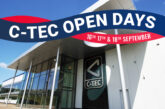
The team at C-TEC explore the different types of hearing assistance solutions available and explain how the company can help you find the right one for your next project.
Hearing assistance systems are required in many public places under BS8300, The Care Standards Act and Part M of the Building Regulations and, the latest version of The Equality Act, insists that anyone offering goods, facilities or services to the general public must make ‘reasonable’ adjustments to ensure they do not directly or indirectly discriminate against hearing impaired people or even discriminate by association.
In the current climate, this legislation is vital as, according to RNID, a staggering 11 million people (that’s one in six of the UK population) are deaf or hard of hearing. And a significant portion of those people have hearing aids. People with hearing loss are more likely to experience emotional distress and loneliness and twice as likely to develop depression and dementia. Fortunately, there are a wide variety of assistive listening (AL) systems on the market specifically designed to help the hearing impaired and these are as follows:
Infrared systems
An infrared listening system transmits sound over infrared to compatible hearing devices without amplifying ambient noise. Such systems typically comprise an audio source such as a microphone or PA system, a mixer (to generate a line level input from the audio source), a modulator and radiator (to transmit the infrared signal) and an infrared receiver such as an IR stethoscope (to receive the infrared signal). Although they tend to be more expensive than hearing loop systems and require the supply, management and maintenance of custom IR receivers, infrared systems provide excellent sound quality, line of sight operation and no field wiring.
Through-counter speech systems
Through counter speech systems are effectively window intercom systems that help make ticket counters, reception desks and other areas with a Perspex or glazed screen more accessible. The vast majority on the market can be paired with a hearing loop amplifier to allow the audio to be broadcast directly to a compatible hearing aid. Such systems are now increasingly popular thanks to the pandemic as they allow social distancing to be maintained by making conversations easier for everyone, including people wearing masks.
Hearing loop systems
Of all the AL systems available, hearing loop systems are by far the most popular and cost-effective and they are used worldwide to allow the hearing impaired to hear more clearly. Most hearing aids have a ‘T’ or ‘MT’ switch which allows them to pick up the electromagnetic field generated by a hearing loop system. The hearing aid converts this signal into a sound suited to its user’s specific hearing requirements. Any person with a hearing aid positioned within or near the loop can hear the loop signal by switching their hearing aid to the correct position, allowing them to participate more effectively in general conversation, ordering goods or services, listening to public performances, etc.
Specialist hearing loop systems
In more complex applications – such as in buildings with a high metal content or in arts venues, theatres and music rooms – where minimal overspill and consistent coverage throughout is essential, a phased array loop system is recommended. The phase-shifting amplifier produces two signals that are 90° out of phase with each other. These signals are connected to two hearing loops laid out in a special overlapping pattern. The resultant magnetic field is evenly spread within the covered area and the field strength falls off very quickly outside the loop, thus avoiding ‘dead spots’ (the areas directly above or below the loop cable where the signal suddenly drops to zero and cuts out sound altogether). The current flowing through the two hearing loops generates a magnetic field that radiates around the loop cable. Within the covered area, people with hearing aids switched to the T or MT position or a person with a cochlear implant can hear more clearly.
Free technical design service and training
The installation of a hearing assistance system is recognised as an adjustment an organisation can make to help comply with the Equality Act. C-TEC manufactures the UK’s widest range of hearing loop amplifiers, kits, microphones, connector plates and test equipment and we offer our customers a wealth of technical support, including a free hearing assistance design service which can save them time and money.
In addition, we host regular free-of-charge hearing loop training sessions at our HQ in Wigan to provide installers, sales engineers and architects with a detailed overview of why, where and how our PDA Range of hearing loop systems are used. The session also includes a section on how to test a hearing system to BS EN 60118-4 (Magnetic strength in audio-frequency hearing loops for hearing aid purposes). A one-hour online CPD session entitled ‘Hearing Assistance Solutions – The Route to DDA/Equality Act Compliance (CPD)’ is also available on request.
Get more details about C-TEC’s full range of hearing assistance solutions here













